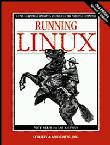

For those unfamiliar with Linux, and with little prior experience with any other Unix-type operating system, Running Linux offers a mountain of well-structured information to help get you on your feet.

Authors: Matt Welsh and Lar Kaufman
Publisher: O'Reilly and Associates
E-mail: info@oreilly.com
URL: http://www.oreilly.com/
Price: $29.95 US
ISBN: 1-56592-151-8
Reviewer: Zach Beane
Running Linux provides a quick introduction to a wide variety of topics related to installing, configuring and using Linux. It covers installation in depth and introduces other topics by giving an overview with examples and referring the reader to other good resources. Depending on your view, the resource pointers, which are used extensively, can be a strength or weakness.
For those unfamiliar with Linux, and with little prior experience with any other Unix-type operating system, Running Linux offers a mountain of well-structured information to help get you on your feet. Unlike some other introductory books, it rarely gets bogged down with too many details about a particular feature, task or program.
In the course of reading Running Linux, you will be introduced to virtually all aspects of using and maintaining your new Linux system. For those left puzzled by their first root shell prompt, it provides a comprehensive path to becoming a Linux user/administrator, from adding accounts to changing passwords to configuring printers.
From there, Running Linux also provides information about fun, interesting and even profitable things to do with your system. Each of these sections are laid out clearly and conveniently. The chapter on programming, for example, offers an overview of popular editors, debuggers and their interfaces and programming languages, giving you a taste of each and allowing you to follow-up with other references.
The references, too, are comprehensive, including HOWTOs, info and man pages, web and ftp sites and other books. Readers may be disappointed at the frequent need to refer to outside sources to get more information—this definitely isn't the only Linux book or resource you'll ever need. From this shortcoming, however, comes an interesting strength; the book often gives pointers to resources that are continually kept up to date, eliminating the pitfall of going into depth about a program feature and then having a new version of the software render the information obsolete.
If you're an experienced Unix or Linux user, you may find that there isn't much material covered that you haven't run into at one time or another. Since no subject is covered in great depth, you're not likely to find some hidden piece of information about a program you've been using for a while. However, the scope of the book is such that even if you've been hacking away for a few years, you'll probably still find some bit of information you never knew before. In addition, if you haven't used GNU or other freely available tools before, Running Linux is a fairly good introduction, although if you have a specific tool in mind, a specific book would probably be a better source of information.
While Running Linux is in its second edition, there are a few fairly dated passages, but these are not common. This is quite forgiveable, for Linux is constantly changing and updating, and any book about Linux initially written over two years ago is bound to have them. Another minor disappointment is the chapter on multimedia which provides only a cursory glimpse at the subject.
Running Linux is a worthwhile book for the Linux newcomer. Veterans to Linux and Unix may find it interesting, but not as useful.